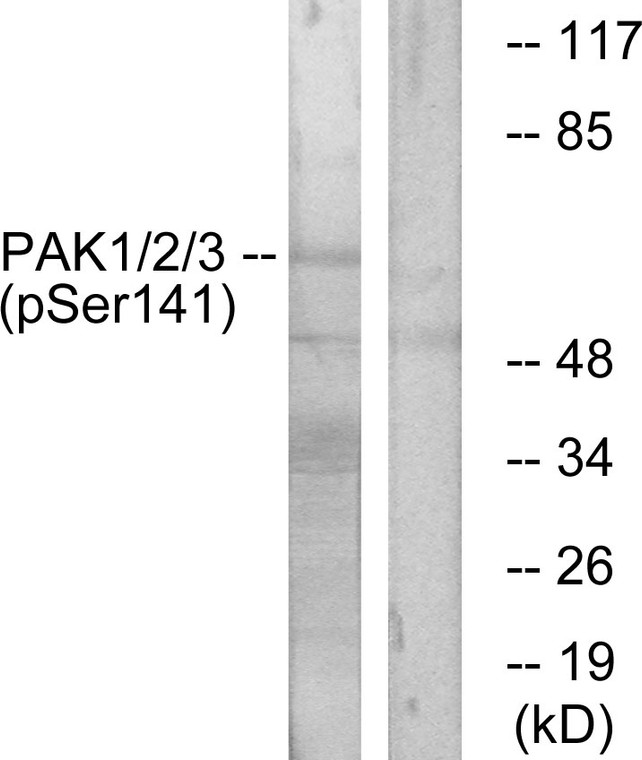| Host: |
Rabbit |
| Applications: |
WB/IHC/IF/ELISA |
| Reactivity: |
Human/Mouse/Rat |
| Note: |
STRICTLY FOR FURTHER SCIENTIFIC RESEARCH USE ONLY (RUO). MUST NOT TO BE USED IN DIAGNOSTIC OR THERAPEUTIC APPLICATIONS. |
| Short Description: |
Rabbit polyclonal antibody anti-Phospho-Serine/threonine-protein kinase PAK 1 and Serine/threonine-protein kinase PAK 2 and Serine/threonine-protein kinase PAK 3-Ser144/141/139 (111-160 aa) is suitable for use in Western Blot, Immunohistochemistry, I |
| Clonality: |
Polyclonal |
| Conjugation: |
Unconjugated |
| Isotype: |
IgG |
| Formulation: |
Liquid in PBS containing 50% Glycerol, 0.5% BSA and 0.02% Sodium Azide. |
| Purification: |
The antibody was affinity-purified from rabbit antiserum by affinity-chromatography using epitope-specific immunogen. |
| Concentration: |
1 mg/mL |
| Dilution Range: |
WB 1:500-1:2000IHC 1:100-1:300ELISA 1:10000IF 1:50-200 |
| Storage Instruction: |
Store at-20°C for up to 1 year from the date of receipt, and avoid repeat freeze-thaw cycles. |
| Gene Symbol: |
PAK2PAK1506250585063PAK2_HUMANPAK1_HUMANPAK3_HUMAN
|
| Immunogen Region: |
111-160 aa |
| Specificity: |
Phospho-PAK Alpha/Beta/Gamma (S144/141/139) Polyclonal Antibody detects endogenous levels of PAK Alpha/Beta/Gamma protein only when phosphorylated at S144/141/139. |
| Immunogen: |
The antiserum was produced against synthesized peptide derived from the human PAK1/2/3 around the phosphorylation site of Ser144/141/139 at the amino acid range 111-160 |
| Post Translational Modifications | Autophosphorylated in trans, meaning that in a dimer, one kinase molecule phosphorylates the other one. Activated by autophosphorylation at Thr-423 in response to a conformation change, triggered by interaction with GTP-bound CDC42 or RAC1. Activated by phosphorylation at Thr-423 by BRSK2 and by PDPK1. Phosphorylated by JAK2 in response to PRL.this increases PAK1 kinase activity. Phosphorylated at Ser-21 by PKB/AKT.this reduces interaction with NCK1 and association with focal adhesion sites. Upon DNA damage, phosphorylated at Thr-212 and translocates to the nucleoplasm. Phosphorylated at tyrosine residues, which can be enhanced by NTN1. |
| Function | Protein kinase involved in intracellular signaling pathways downstream of integrins and receptor-type kinases that plays an important role in cytoskeleton dynamics, in cell adhesion, migration, proliferation, apoptosis, mitosis, and in vesicle-mediated transport processes. Can directly phosphorylate BAD and protects cells against apoptosis. Activated by interaction with CDC42 and RAC1. Functions as GTPase effector that links the Rho-related GTPases CDC42 and RAC1 to the JNK MAP kinase pathway. Phosphorylates and activates MAP2K1, and thereby mediates activation of downstream MAP kinases. Involved in the reorganization of the actin cytoskeleton, actin stress fibers and of focal adhesion complexes. Phosphorylates the tubulin chaperone TBCB and thereby plays a role in the regulation of microtubule biogenesis and organization of the tubulin cytoskeleton. Plays a role in the regulation of insulin secretion in response to elevated glucose levels. Part of a ternary complex that contains PAK1, DVL1 and MUSK that is important for MUSK-dependent regulation of AChR clustering during the formation of the neuromuscular junction (NMJ). Activity is inhibited in cells undergoing apoptosis, potentially due to binding of CDC2L1 and CDC2L2. Phosphorylates MYL9/MLC2. Phosphorylates RAF1 at 'Ser-338' and 'Ser-339' resulting in: activation of RAF1, stimulation of RAF1 translocation to mitochondria, phosphorylation of BAD by RAF1, and RAF1 binding to BCL2. Phosphorylates SNAI1 at 'Ser-246' promoting its transcriptional repressor activity by increasing its accumulation in the nucleus. In podocytes, promotes NR3C2 nuclear localization. Required for atypical chemokine receptor ACKR2-induced phosphorylation of LIMK1 and cofilin (CFL1) and for the up-regulation of ACKR2 from endosomal compartment to cell membrane, increasing its efficiency in chemokine uptake and degradation. In synapses, seems to mediate the regulation of F-actin cluster formation performed by SHANK3, maybe through CFL1 phosphorylation and inactivation. Plays a role in RUFY3-mediated facilitating gastric cancer cells migration and invasion. In response to DNA damage, phosphorylates MORC2 which activates its ATPase activity and facilitates chromatin remodeling. |
| Protein Name | Serine/Threonine-Protein Kinase Pak 1Alpha-PakP21-Activated Kinase 1Pak-1P65-Pak |
| Database Links | Reactome: R-HSA-202433Reactome: R-HSA-2029482Reactome: R-HSA-2871796Reactome: R-HSA-376172Reactome: R-HSA-389359Reactome: R-HSA-3928662Reactome: R-HSA-3928664Reactome: R-HSA-399954Reactome: R-HSA-428540Reactome: R-HSA-445144Reactome: R-HSA-445355Reactome: R-HSA-5218920Reactome: R-HSA-5621575Reactome: R-HSA-5625740Reactome: R-HSA-5627117Reactome: R-HSA-5627123Reactome: R-HSA-5687128Reactome: R-HSA-8964616 |
| Cellular Localisation | CytoplasmCell JunctionFocal AdhesionCell MembraneCell ProjectionRuffle MembraneInvadopodiumNucleusNucleoplasmChromosomeColocalizes With Rufy3F-Actin And Other Core Migration Components In Invadopodia At The Cell PeripheryRecruited To The Cell Membrane By Interaction With Cdc42 And Rac1Recruited To Focal Adhesions Upon ActivationColocalized With Cib1 Within Membrane Ruffles During Cell Spreading Upon Readhesion To FibronectinUpon Dna DamageTranslocates To The Nucleoplasm When Phosphorylated At Thr-212 Where Is Co-Recruited With Morc2 On Damaged Chromatin |
| Alternative Antibody Names | Anti-Serine/Threonine-Protein Kinase Pak 1 antibodyAnti-Alpha-Pak antibodyAnti-P21-Activated Kinase 1 antibodyAnti-Pak-1 antibodyAnti-P65-Pak antibodyAnti-PAK1 antibody |
Information sourced from Uniprot.org
12 months for antibodies. 6 months for ELISA Kits. Please see website T&Cs for further guidance








